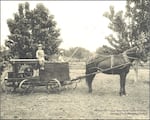
A Wenatchee Sprayer made by A. D. Browning, Wenatchee. Two men, one with bamboo spray pole, and one small boy sitting on top of sprayer pulled by one horse in a fruit orchard in Wenatchee. Because farmers did not know of the potential toxicity or longevity of pesticides in use at the time, Washington law exempts farmers from being liable for contamination from legally applied pesticides.
T. Gagnon / Courtesy of Wenatchee Valley Museum & Cultural Center
A liable party makes a world of difference for Washington's Department of Ecology. When the agency finds pollution, being able to point the finger at a specific company means funding for its cleanup programs.
That's what happened in Tacoma, where the state won a $95 million settlement in 2009 with Asarco, which operated a smelter in the area. It left lead and arsenic contamination throughout more than 400,000 acres of Pierce and King counties.
That’s not what happened in Central Washington, where pesticides on now long-gone orchards left lead and arsenic in the soil across an estimated 187,000 acres. Decades ago, small-scale farmers and orchardists applied those pesticides through legal means and likely without knowledge of future harm. For that, state laws exempts them from liability.
In Western Washington, that $95 million has led to testing at more than 1,300 schools, parks and day cares and 1,500 homes, with hundreds of cleanup sites. Ecology has an outreach program with a van, mascots and media advertising.
The agency also has a website that lets people look up an address and find information about suspected contamination and cleanups.
In Central Washington, 26 schools and two parks have been cleaned up. No other parks, homes or day cares have been addressed. There is no public outreach campaign. The agency compiled an incomplete database of former orchards, never put it online and can no longer locate it.
Critics of the agency’s handling of former orchard contamination point to the the disparity on the east and west sides of the Washington Cascades.
“There’s more that they could do. It’s quite apparent. They’re doing it on the west side,” said Norm Hepner, a former Ecology employee who worked on lead arsenic cleanups.
But it’s not that simple.
Special Report
There's more in our report on legacy contamination on former orchards:
- Contaminated Soil Lingers Where Apples Once Grew
- Tips For Staying Safe Around Contaminated Soil
- How A Banned Chemical Helped Clean Up Washington's Orchards
- NW Officials Aren't Testing Yards Suspected Of Lead And Arsenic Contamination. So We Did.
Smelter contamination is a bull's-eye, with the highest contamination nearest the smelter sites and lower concentrations fanning outward. That makes the agency’s online tool fairly straightforward and reliable.
Finding contamination in Central Washington is a crapshoot. The area is peppered with hotspots where lead arsenate was applied or stored or mixed.
Much soil has also been used as fill dirt, moved from place to place. Valerie Bound, toxics cleanup manager for Ecology’s Central Washington region, said in some cases the agency found contamination in places she didn’t expect and clean soil where she suspected contamination.
There’s also the issue of financial resources.
Bound said she has 12 people when fully staffed to deal with more than 500 contaminated sites. She ran out of funding for lead and arsenic contamination and does not plan to ask for more. Her agency and the Legislature have prioritized other cleanups, she said.
“If you want to start a whole other program about, 'now we want to clean up parks,' and 'now we want to do child cares,' that’s just a lot, you know?” Bound said. “I think, it’s just a question of priority and money and resources. And there’s all sorts of things I wish I could do.”
Read the full story here.
